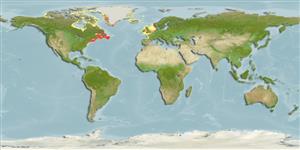Environment: milieu / climate zone / depth range / distribution range
Ecology
Marine; demersal; depth range 0 - 108 m (Ref. 58426). Polar; 84°N - 36°N, 127°W - 6°E (Ref. 57357)
North Atlantic: Greenland to North Carolina. Also in the northeast Atlantic (Ref. 7251).
Size / Weight / Age
Maturity: Lm ? range ? - ? cm
Max length : 25.0 cm TL male/unsexed; (Ref. 7251)
Occurs farther offshore in salinities of 30-36 ppt. Minimum depth reported taken from Ref. 57178. Benthic. Feeds on crustaceans and worms (Ref. 58426); mainly on copepod, Calanus finmarchicus (Ref. 5951).
Life cycle and mating behavior
Maturity | Reproduction | Spawning | Eggs | Fecundity | Larvae
Robins, C.R. and G.C. Ray, 1986. A field guide to Atlantic coast fishes of North America. Houghton Mifflin Company, Boston, U.S.A. 354 p. (Ref. 7251)
IUCN Red List Status (Ref. 130435: Version 2024-1)
Threat to humans
Harmless
Human uses
Fisheries: of potential interest
Tools
Special reports
Download XML
Internet sources
Estimates based on models
Preferred temperature (Ref.
123201): 1.2 - 12.8, mean 7.2 °C (based on 218 cells).
Phylogenetic diversity index (Ref.
82804): PD
50 = 0.5156 [Uniqueness, from 0.5 = low to 2.0 = high].
Bayesian length-weight: a=0.00240 (0.00127 - 0.00453), b=3.05 (2.89 - 3.21), in cm total length, based on LWR estimates for this species & Genus-body shape (Ref.
93245).
Trophic level (Ref.
69278): 3.2 ±0.1 se; based on diet studies.
Resilience (Ref.
120179): Medium, minimum population doubling time 1.4 - 4.4 years (K=0.33-0.38; tmax=9).
Fishing Vulnerability (Ref.
59153): Low to moderate vulnerability (33 of 100).
